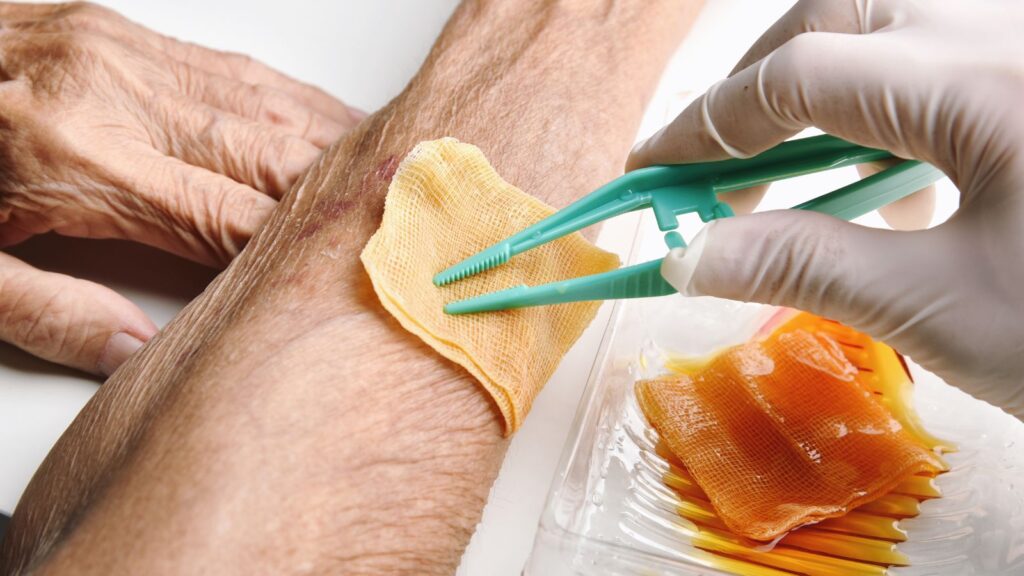In today’s world, effective wound care management is crucial for promoting healing and preventing infection. Antimicrobial dressings offer a powerful solution in addressing these concerns.
This informative blog post will delve into the benefits, uses, and types of antimicrobial dressings that have revolutionized wound care practices. Discover how these advanced medical products promote faster healing while reducing the risks associated with infections and complications.
Key Takeaways
- Antimicrobial dressings contain agents designed to kill or prevent the growth of microorganisms, such as bacteria or fungi, within or on the dressing. They create a moist wound environment while neutralizing bacteria and reducing the risk of infection.
- Benefits of using antimicrobial dressings include reduced risk of infection, faster healing times, lower healthcare costs, improved wound management, and increased patient comfort.
- Common uses for antimicrobial dressings include wound care, burn wounds, surgical incisions, diabetic ulcers and pressure ulcers. Choosing the right type of dressing based on the severity and location of the injury is crucial for optimal results.
- The active agents in antimicrobial dressings work by targeting bacterial cell walls and enzymes to disrupt their metabolic processes and kill them. Dressings with gel-forming agents provide an ideal environment for cells to regenerate while also protecting against infection. Applying an antimicrobial dressing can significantly improve wound management for those living off grid where access to medical resources may be limited.
What Are Antimicrobial Dressings?
Antimicrobial dressings are specialized wound dressings that contain agents designed to kill or prevent the growth of microorganisms, such as bacteria or fungi, within or on the dressing.
Definition And Purpose
Antimicrobial dressings serve a critical role in the wound healing process by providing an effective barrier against harmful microorganisms. These specialized medical devices are designed to maintain a moist wound environment while neutralizing bacteria and reducing the risk of infection.
The magic behind these dressings lies in their unique composition which includes antibacterial agents like silver, honey, or iodine that actively combat bacterial growth on and within the dressing itself.
For instance, silver-impregnated dressings release small amounts of silver ions that eliminate bacteria by disrupting cellular processes necessary for survival.
The Science Behind Antimicrobial Properties
Antimicrobial dressings are designed to prevent the growth of microorganisms within them, ultimately preventing infections and enhancing wound healing. The science behind their antimicrobial properties lies in the active agents they contain, such as silver or PHMB.
These agents work by targeting bacterial cell walls and enzymes, disrupting their metabolic processes and killing them. Additionally, some dressings utilize gel-forming agents that create a moist environment conducive to healing while also protecting against infection.
Benefits Of Antimicrobial Dressings
Antimicrobial dressings offer several benefits, including reduced risk of infection, faster healing, lower healthcare costs, improved wound management, and increased patient comfort.
Reduced Risk Of Infection
One significant advantage of using antimicrobial dressings is the reduced risk of infection. When wounds are left untreated, they can become breeding grounds for bacteria and other harmful microorganisms that could cause severe infections.
Antimicrobial dressings help to prevent these infections by creating an environment that inhibits microbial growth within the dressing itself. This barrier effect is particularly useful in remote areas where access to medical facilities may be limited, making it difficult to manage wound care effectively.
For example, people living off-grid may find themselves miles away from a hospital or clinic where proper wound care can be administered regularly.
Faster Healing
Antimicrobial dressings can accelerate the healing process of wounds. By reducing bacterial growth and promoting a moist wound environment, these dressings help to create an ideal condition for natural skin regeneration.
Studies have shown that utilizing antimicrobial dressings can result in reduced time to complete wound closure, less inflammation, and ultimately faster recovery times. For example, using hydrogel antimicrobial dressings can promote speedy wound healing as their water content helps provide a moist environment for cells to regenerate while also aiding in removing dead tissue without disrupting healthy tissue.
Lower Healthcare Costs
Using antimicrobial dressings can also lead to lower healthcare costs. When wounds become infected, treatment can be expensive and time-consuming. Antimicrobial dressings help prevent infections from occurring, reducing the need for additional medical interventions such as antibiotics or surgery.
In addition, faster healing times with antimicrobial dressings mean less frequent dressing changes and fewer visits to healthcare providers. This not only saves money but also reduces the environmental impact of medical waste disposal.
Improved Wound Management
Antimicrobial dressings not only help to reduce the risk of infection and promote faster healing but also significantly improve wound management. By creating a moist environment, these dressings provide an optimal environment for cells to migrate and grow while preventing them from drying out.
This minimizes scarring and enhances skin regeneration, ultimately leading to quicker recovery times. In addition, antimicrobial dressings come in various forms that cater specifically to different types of wounds such as burns, leg ulcers, surgical incisions, diabetic ulcers, pressure ulcers and so much more.
Increased Patient Comfort
Using antimicrobial dressings can significantly improve patient comfort during the healing process. These types of dressings are gentle on the skin and do not cause friction or irritation, reducing pain and discomfort for patients.
For example, hydrogel dressings are known for their cooling sensation when applied to burn wounds, providing immense relief to patients. PHMB dressings also have a unique ability to manage odor caused by bacterial growth in wounds, enhancing patient comfort.
Common Uses Of Antimicrobial Dressings
Antimicrobial dressings are commonly used for wound care, burn wounds, surgical incisions, diabetic ulcers, and pressure ulcers.
Wound Care
Proper wound care is crucial in preventing infections and promoting healing. Antimicrobial dressings can play a significant role in wound care, as they help reduce the risk of infection and improve overall wound management.
Antimicrobial dressings with gel-forming agents like PHMB have been shown to be effective at attacking bacteria on both the surface of wounds and within the dressing itself, limiting cross-contamination and creating an ideal environment for wound healing.
Burn Wounds
Burn wounds are injuries caused by heat, chemicals, electricity, or radiation. They are often painful and take longer to heal than other types of wounds. Antimicrobial dressings play a vital role in managing burn wounds by reducing the risk of infection and promoting faster healing.
Silver-based dressings have been found to be particularly effective in treating burns as they provide broad-spectrum bacterial activity against many different types of bacteria.
Additionally, antimicrobial dressings with hydrogel can help soothe the pain associated with these types of wounds while also keeping the wound moist to promote faster healing.
Surgical Incisions
Antimicrobial dressings are also commonly used for surgical incisions. These types of wounds are at a high risk of infection due to their exposure during surgery, and it is crucial to use wound dressings that can effectively reduce this risk.
Antimicrobial dressings with gel-forming agents, such as hydrogel or collagen-based dressings, are often used in these cases as they provide a moist wound healing environment and help manage the bioburden within the wound.
By using an antimicrobial dressing on a surgical incision, patients can experience faster healing times while reducing the risk of complications from infections such as sepsis or necrotizing fasciitis.
Diabetic Ulcers
Diabetic ulcers are a common complication of diabetes that occur when high blood sugar levels damage the nerves and blood vessels in the feet, making it difficult for wounds to heal.
Antimicrobial dressings can be an effective treatment option for diabetic ulcers as they help reduce the risk of infection and promote faster healing. Applying an antimicrobial dressing to a diabetic ulcer also helps manage exudate, which is important in maintaining an optimal wound environment.
It’s essential to understand the types of antimicrobial dressings available and consult with your healthcare provider before choosing one that suits your specific needs.
Pressure Ulcers
Pressure ulcers, also known as bedsores, are a common problem among off grid living populations. These sores develop when pressure is applied to an area of the skin for a long time, often due to lack of mobility or proper cushioning.
Antimicrobial dressings can be particularly useful for preventing and treating pressure ulcers, as they help reduce the risk of infection while promoting faster wound healing.
The use of foam dressings with silver or PHMB can provide an ideal moist wound healing environment while reducing bioburden and bacterial growth within the dressing.
Types Of Antimicrobial Dressings
Antimicrobial dressings come in various types such as silver, iodine, honey, chlorhexidine and PHMB dressings.
Silver Dressings
Silver dressings are a type of antimicrobial dressing that contain silver as an active ingredient. Silver has natural antibacterial properties that can help prevent and treat infections in wounds.
These types of dressings commonly come in the form of gels, foams, or films.
Silver dressings are especially effective for burn wounds and chronic wounds like diabetic ulcers. They work by releasing silver ions into the wound bed which promotes healing while limiting bacterial growth within the dressing itself.
Additionally, they provide a moist environment that is conducive to faster healing and higher patient comfort compared to traditional dry dressings.
Iodine Dressings

Iodine dressings are another type of antimicrobial dressing that is commonly used to promote wound healing. These dressings use the power of iodine, a natural antiseptic, to prevent bacterial growth on and around the wound site.
Iodine dressings are effective in controlling bacteria such as MRSA and Pseudomonas aeruginosa, which can cause serious infections if left untreated. The benefit of using iodine-based dressings is that they not only prevent infection but also help in the debridement process by breaking down dead tissue on the wound surface.
Honey Dressings
Honey dressings are a type of wound dressing with antimicrobial properties. These dressings contain medical-grade honey, which has been used for centuries to promote wound healing and prevent infection.
Medical-grade honey is highly effective in reducing the bioburden (the number of bacteria or microorganisms present) within the wound bed.
One of the benefits of using honey dressings is that they are natural and non-toxic, making them an ideal option for those living off-grid without access to traditional medical treatments.
Honey dressings can be especially useful for treating chronic wounds such as diabetic ulcers or pressure ulcers, which may not respond well to other types of treatment.
Chlorhexidine Dressings
Chlorhexidine is an antiseptic agent that has both bactericidal and bacteriostatic effects on bacteria. Chlorhexidine dressings are commonly used to prevent and treat bacterial infections in wounds.
These dressings release chlorhexidine into the wound bed, which helps reduce bacterial growth and promote healing. Chlorhexidine dressings can be particularly useful for individuals who live off-grid or have limited access to medical care because they require less frequent dressing changes compared to other types of antimicrobial dressings.
PHMB Dressings
PHMB dressings are a type of antimicrobial dressing that contains Polyhexamethylene biguanide, which is an effective agent against bacteria. This dressing is designed to limit cross-contamination and promote a healthy healing environment by attacking bacteria both on and within the dressing.
It can be useful in preventing wound infections and promoting faster recovery, making it a popular choice for those who prefer off-grid living where access to healthcare may be limited.
PHMB dressings often come in forms such as foam or gel-based products and are commonly used for leg ulcers, burns, and other types of wounds.
How To Choose The Right Antimicrobial Dressing
Consider factors such as wound type, exudate levels, and the patient’s medical history when choosing an antimicrobial dressing; read on to learn more about how to select the best option for your needs.
Factors To Consider
When selecting the right antimicrobial dressing, there are several factors to consider. The type of wound, its location and severity, and the patient’s health status are all important when deciding on an appropriate dressing.
For instance, silver dressings may be more effective for wounds with heavy bioburden or bacterial growth while foam dressings may be better suited for wounds with moderate or light exudate.
It is also essential to consult with a healthcare provider for specific recommendations as they can provide personalized advice based on individual needs.
Additionally, patients should consider their lifestyle and comfort level when choosing between different types of antimicrobial dressings. Some dressings may require frequent changes or certain precautions during use that could affect daily activities.
Choosing a comfortable and practical dressing that meets both medical needs and personal preferences can help improve overall satisfaction with treatment outcomes.
Consult With Healthcare Provider
Before choosing and using any antimicrobial dressing, it is essential to consult with a healthcare provider. They can help you determine the best type of dressing for your specific situation and provide guidance on proper application and maintenance.
For example, if you have a chronic wound, such as a diabetic ulcer or pressure sore, your healthcare provider may recommend dressings containing collagen or foam for optimal moist wound healing.
In addition, consulting with your healthcare provider ensures that underlying conditions that may be contributing to the wound are identified and addressed during treatment.
Proper Application And Maintenance
Proper application and maintenance are crucial for the effectiveness of antimicrobial dressings. The first step is to identify the type of wound, the amount of exudate, and how frequently to change dressings.
It’s important to clean the wound thoroughly before applying the dressing and wear gloves during application to prevent contamination. To ensure proper adhesion, make sure that skin surrounding the wound is dry before placing a new dressing on top.
To maintain efficacy, it’s essential not to disturb or remove dressings unnecessarily before they’re due for replacement as this can disrupt healing progress and increase bacterial contamination risks.
By following these simple guidelines in choosing and using antimicrobial dressings properly when treating wounds off-grid living becomes more manageable while reducing healthcare costs significantly.
Conclusion
In conclusion, using antimicrobial dressings is a great way to promote wound healing. They reduce the risk of infections and prevent bacterial growth in the dressing, ultimately leading to faster healing times, lower healthcare costs, improved wound management, and increased patient comfort.
There are several types of antimicrobial dressings available on the market today such as silver dressings and PHMB dressings that attack bacteria on and within the dressing preventing cross-contamination.
Choosing the right antimicrobial dressing requires considering factors such as type of wound and consultation with healthcare providers for proper application and maintenance.
FAQs:
1. What are the benefits of using antimicrobial dressings?
Antimicrobial dressings can help prevent the growth and spread of harmful bacteria, reduce the risk of infection in wounds, speed up healing time, promote tissue regeneration and improve overall wound care management.
2. How do antimicrobial dressings work?
Antimicrobial agents such as silver or iodine are incorporated into the dressing material to inhibit bacterial growth and protect against infection. This helps to maintain a clean and healthy environment around the wound.
3. What types of wounds are suitable for antimicrobial dressings?
Antimicrobial dressings can be used for a variety of wounds including surgical incisions, burns, pressure ulcers, diabetic foot ulcers, leg ulcers and infected cuts or abrasions.
4. Are there any precautions I should take when using antimicrobial dressings?
It is important to follow all instructions provided by your healthcare professional when using antimicrobial dressings to ensure they are applied correctly and safely. Additionally, people who have an allergy to certain types of metals may need to avoid silver-based products due to potential skin reactions.




